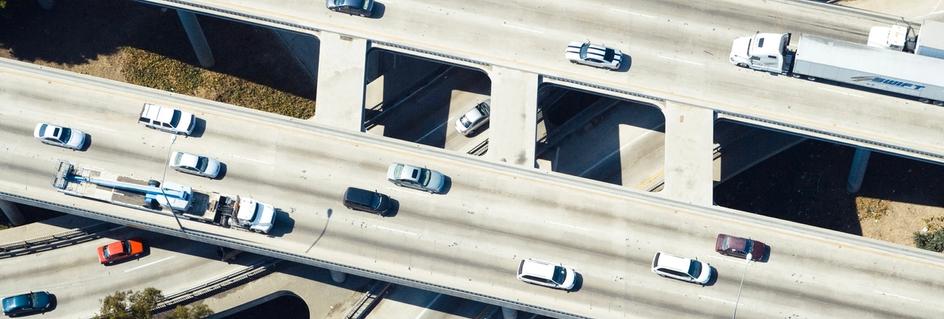LA2050 Blog
We’ve got access to the information that every Angeleno needs to make an impact. Our blog features the latest LA2050 news, announcements, features, happenings, grantee updates, and more.

A glimpse into LA's future: How can driverless vehicles & new tech revolutionize a car city?
PostedLA might be known to some as a congested, car-centric city, but Angelenos know these stereotypes are old news. LA's got rapid changes underway that are making our beloved city more people-friendly every single day.
We're investing in public transportation with new rail and bus projects, like the Expo line connecting downtown to Santa Monica, the final phase of which opened this summer and has seen dramatic spikes in popularity. We're adding bike-share programs and bike lanes, and making communities more walkable. And we're big adopters of ride-sharing apps and other new technology.
LA is the ultimate testing ground for innovative ideas in mobility -- and proud of it!
These efforts got a huge boost recently thanks to the leadership of Seleta Reynolds, General Manager of the Los Angeles Department of Transportation (LADOT), which released a report examining how the future of LA's transportation could look and how we should start preparing!
Supported by the Goldhirsh Foundation in partnership with the Mayor's Fund of Los Angeles, the comprehensive strategy, “Urban Mobility in a Digital Age: A Transportation Technology Strategy for Los Angeles," is the first strategy document of its kind from a major U.S. city to focus prominently on how autonomous vehicles could improve mobility in LA.
The pages of the document are bursting with exciting ideas. Here are a few of our faves:
- Test mobility feedback tools: We love the idea of giving Angelenos the opportunity to provide feedback on their walking, biking and public transportation experiences quickly and easily via technology -- just like you'd rate an Uber or Lyft ride. The report recommends LADOT set metrics to help define and evaluate “transportation happiness."
- Use smart parking tech: Google maps (or your map app of choice) will let you know how long it takes to drive from place to place -- and even consider the traffic -- but what about how long it will take you to park? Every single Angeleno who drives knows what it's like to arrive on time, but then to wind up late because of driving around looking for parking.
Furthermore, studies have found that 30 percent of traffic is caused by drivers looking for curb parking, and a UCLA study estimated this generates an extra 730 tons of CO2 emissions annually in just one small business district alone. According to the EPA's greenhouse gas calculator, 730 tons of CO2 is equal to the amount of CO2 that would be sequestered by 18,919 tree seedlings grown for 10 years. Making greater use of parking inventory technology will help drivers find a space more quickly thereby reducing excess CO2 emissions. But equally important, including these time estimates provides a more realistic picture for drivers and may encourage walking, using public transportation or a ridesharing service instead. - Test autonomous public transit vehicles: It's not just ride-sharing companies and car manufacturers that should be testing autonomous vehicles (AV). It's time for LA's transit agencies to get the ball rolling too. Can you imagine hopping on a self-driving bus?
- Test on-demand shuttles: In LA, first mile/last mile is often our biggest stumbling block to public transportation adoption, i.e. how Angelenos get from their nearest bus or rail stop to their door. One amazing idea is piloting on-demand public transportation options, like micro-buses or shuttles, in lieu of fixed-route buses, to help riders make their first mile/last mile connections.
- Expand car-free zones: Of course we adore the idea of increasing the frequency of temporary car-free zones, like CicLAvia, which encourage Angelenos to explore their communities on bikes and on foot. It's currently held three times a year. How would LA's streets change if this was a more regular option?
- Crowdsource transit improvements: We sure love crowdsourcing! The report suggests LADOT partner with the community to crowdsource ideas and even funding to make bus stops more comfortable and informative for riders (think more shade, most seating and info on arrival times).
- Launch a mobility lab: LADOT should foster innovation by hosting a “living lab" for their teams to share data/research and collaborate on new ideas with private sector transpo tech companies, as well as academic and philanthropic partners. We couldn't agree more!
These changes would have big implications for Los Angeles and could spur new uses for tons of space across the region. A 2015 report found parking took up an estimated 14 percent of land across the county in 2010 and the number may be even higher today.
Think of what opportunities and options could be unlocked if we move away from individual car ownership and reclaim urban spaces taken up by parking. We could convert parking spaces into new parks across LA, build much-needed new housing and explore creative land uses we haven't yet imagined.
That's just one of the many ways the lived experience of Angelenos could be improved by this new model, which would also reduce traffic and transit times, improve walkability and bikeability of neighborhoods, make residents more active, increase community connectivity and dramatically reduce carbon emissions. We love these positive impacts and the steps LADOT is exploring to bring them to fruition.
For more on the future of mobility in LA, check out Alissa Walker's excellent piece on the report in Curbed LA. Then, grab a nice glass of your favorite beverage, get cozy and enjoy the full report.